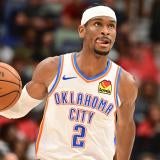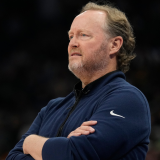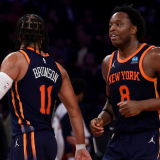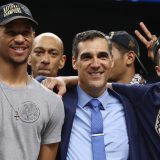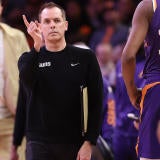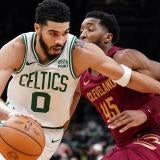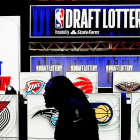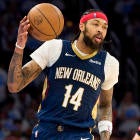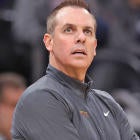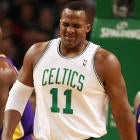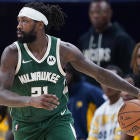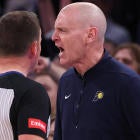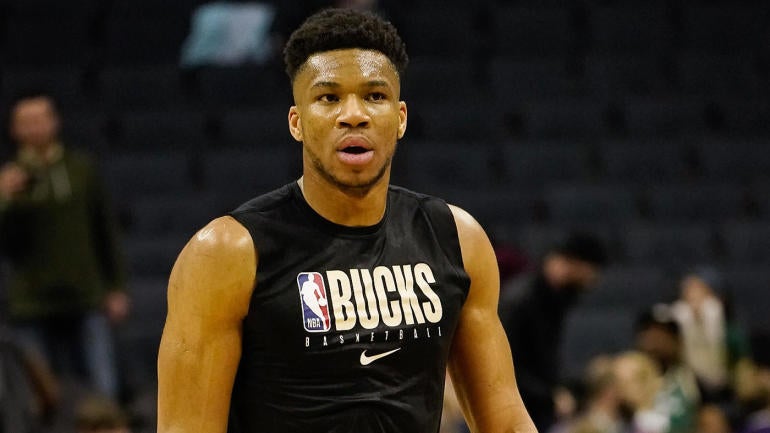
Monday was unusually active for the final day of the offseason. While that date on the calendar has served as the deadline for first-round picks with three years of experience to sign rookie contract extensions, Monday's flurry of activity was extreme even by the standards of that milestone. Over the past seven seasons, the league has gotten an average of 6.8 rookie extensions per offseason. When Monday's deadline arrived, though, a total of 10 2017 first-round picks had signed extensions, the most in that period.
These weren't exactly cheap contracts, either. Markelle Fultz will earn $50 million over three years, and he has played in only 105 career games. Luke Kennard guaranteed himself even more, $56 million with another $8 million in incentives available, despite a similarly sparse track record. He broke out to average a career-high 15.8 points per game last season, but appeared in only 28 games in the process. Jonathan Isaac secured himself $80 million despite the likelihood that he misses this season recovering from a torn ACL, to say nothing of the other injuries he's sustained as a pro.
Price tags on rookie extensions are almost always high. Potential is baked into the negotiations. But we're in the middle of a pandemic that is going to restrict revenue this season. The raises built into existing contracts are probably going to outpace growth in the salary cap and luxury tax in the immediate future. In theory, all of this is should be limiting spending. Instead, teams handed out high-risk extensions like candy. So what gives?
Well, the 2017 draft class wasn't the only group negotiating extensions this offseason. The All-NBA Teams were busy securing their own bags as well. Six veterans signed long-term extensions this offseason. You've probably read about at least four of them: LeBron James, Paul George, Rudy Gobert and Giannis Antetokounmpo.
Antetokounmpo is the most important of the four, but think about what the group represents. The 2021 free-agent class was supposed to be among the best in league history. Well, now, only two 2020 All-Stars remain, assuming Chris Paul picks up his player option, and these deals should serve to drive the others home as well. George re-signing with the Clippers makes it likelier that Kawhi Leonard follows suit, as he doesn't have to worry about losing his co-star. Antetokounmpo is the true driving force here, though. For starters, his extension practically ensures that fellow Milwaukee free agent Jrue Holiday remains with the Bucks, but his true influence on this process extends much further.
Teams have been preparing for Antetokounmpo's free agency for years. The result is an offseason projected to include more cap space than any since the 2016 spike. According to Spotrac, 14 teams are projected to have at least $10 million in practical cap space. That's nearly half of the league operating as below-the-cap teams, free to spend more than the mid-level exception on a class of free agents that no longer has the talent to adequately fill that space. This creates a serious supply-and-demand problem.
The last time the league faced this kind of talent vacuum in free agency was that 2016 spike. Think about some of the contracts that were signed that offseason. Does $64 million for Kennard seem so outlandish compared to the $64 million Ian Mahinmi and Timofey Mozgov got? Of course not. When there's too much space for not enough talent, teams get desperate and throw their money around like drunken sailors.
This is especially problematic when it comes to restricted free agents. When teams are unsatisfied with the talent available, they start talking themselves into potential. The Brooklyn Nets alone offered Allen Crabbe $75 million and Tyler Johnson $50 million. A year later, they tried to nab Otto Porter Jr. for $106 million. All three of their original teams matched the offer sheets out of fear of losing the assets for nothing. All three regretted it. All three finished those contracts on different teams. Crabbe and Johnson even made their way to Brooklyn eventually.
So let's play this out. Say you're a desperate younger team sorely in need of shooting. The few worthwhile veterans on the market have been snatched up. Your cap space is burning a hole in your pocket. Suddenly, you hear the siren song of Luke Kennard. You know you have to overpay to scare his original team away, and $64 million might not be enough to do that. So you throw $80 million in his direction instead and call it a day.
Now, the notion of Kennard getting such a windfall might be a bit extreme, but what about Isaac? The Dallas Mavericks just spent a year preparing to chase a game-changing athlete at power forward. The one they wanted, Antetokounmpo, is gone. They've taken health risks before (Kristaps Porzingis). What would stop them from offering $100 million for his services? That is precisely what the teams handing out these extensions were worried about. If they didn't pay up for their youngsters, someone else was going to based on the cap environment alone.
But just because teams expect their rivals to overspend next summer doesn't mean they themselves wanted to. That was the other unintended consequence of all of these veteran extensions. The teams that were hoarding space for 2021 no longer had a reason to. That cap space wasn't valuable, so they decided to apply it to their own players.
This was especially noteworthy in regards to two of the teams most closely associated with Antetokounmpo: the Miami Heat and Toronto Raptors. Both had three-year veterans who were eligible for contract extensions (OG Anunoby for the Raptors, Bam Adebayo for the Heat). Both were heavily incentivized not to extend them, because their restricted free agent cap holds would have been lower than the salaries an extension would have granted them, thereby artificially creating extra cap space (a phenomenon I've covered in more depth here). Yet in the end, both decided to extend their young stars.
The Heat did so before Giannis re-signed, but remember, Antetokounmpo and Adebayo share an agent. The Heat were likely made aware of Giannis' plans and responded accordingly. The Raptors did not extend Anunoby until after news of the new Giannis deal was made known, and they ultimately secured his services for a relative bargain. That space-saving cap hold of his would have been $11.6 million. The $72 million pact he signed will start at around $16 million in the first season. Basically, this means they gave up $4.4 million in 2021 cap space to lock Anunoby into a reasonable deal for at least the next three seasons. Had they made him wait, they might have been able to preserve that short-term space, but likely would have wound up paying Anunoby far more than the $72 million they agreed to. Those cap savings would have been worth it if they'd been the key to chasing Giannis.
But with Giannis and so many other top players no longer available, the Raptors saw no reason to preserve that space. In fact, with Anunoby now signed and so little talent remaining on the market, Toronto might not even function as a cap space team at all, instead choosing to operate above the line in order to retain its own free agents. That includes the last remaining 2020 All-Star to hit the market: Kyle Lowry.
Now, the best remaining players on the market are the impending restricted free agents who didn't get extended by Monday. Players like Lonzo Ball, Lauri Markkanen, Zach Collins and John Collins and Jarrett Allen will now enter such a barren market that teams with spending power will have little choice but to try to overpay them. The teams that did extend their young players may have gone above typical market value to do so, but in the process protected themselves from the sort of gargantuan deals that markets like this tend to create. The overwhelming amount of available cap space out there has to go somewhere. Extending teams paid a premium to make sure it wouldn't go to their own players.







